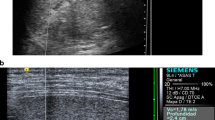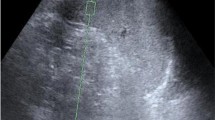Abstract
Background
Living donor liver transplantation in children often results in venous complications, leading to portal hypertension. Spleen stiffness measurements have been recently proposed as a new, noninvasive parameter for portal hypertension in cirrhotic patients.
Objective
To evaluate the diagnostic value of spleen stiffness measurements by acoustic radiation force impulse (ARFI) imaging in diagnosing venous complications after pediatric living donor liver transplantation.
Materials and methods
We prospectively enrolled 69 patients after pediatric living donor liver transplantation using a left-side liver allograft. Around the time of the protocol liver biopsy examination, spleen stiffness measurements by ARFI imaging were performed via the left intercostal space at the center of the spleen parenchyma and repeated five times. Imaging examinations around the time of the spleen stiffness measurements were retrospectively reviewed. Regarding venous complications, significant portal and hepatic venous stenosis was defined as >50% stenosis on multiphasic computed tomography.
Results
After post hoc exclusion, 62 patients were studied. Portal and hepatic venous stenosis was identified in three and two patients, respectively. The median spleen stiffness values were 2.70 and 4.00 m/s in patients without and with venous complications, respectively (P < 0.001). Spleen stiffness measurements showed good diagnostic power for venous complications, and the cutoff value was determined as 2.93 m/s, with 100% sensitivity and 78.9% specificity. Spleen stiffness measurements decreased with the relief of venous stenosis resulting from an interventional radiology procedure.
Conclusion
Spleen stiffness measurements by ARFI imaging might provide a useful quantitative index for venous complications after pediatric living donor liver transplantation.





Similar content being viewed by others
References
Ng VL, Fecteau A, Shepherd R et al (2008) Outcomes of 5-year survivors of pediatric liver transplantation: report on 461 children from a north american multicenter registry. Pediatrics 122:e1128–e1135
Ozawa K, Uemoto S, Tanaka K et al (1992) An appraisal of pediatric liver transplantation from living relatives. Initial clinical experiences in 20 pediatric liver transplantations from living relatives as donors. Ann Surg 216:547–553
Buell JF, Funaki B, Cronin DC et al (2002) Long-term venous complications after full-size and segmental pediatric liver transplantation. Ann Surg 236:658–666
Diamond IR, Fecteau A, Millis JM et al (2007) Impact of graft type on outcome in pediatric liver transplantation: a report From Studies of Pediatric Liver Transplantation (SPLIT). Ann Surg 246:301–310
Ueda M, Oike F, Kasahara M et al (2008) Portal vein complications in pediatric living donor liver transplantation using left-side grafts. Am J Transplant 8:2097–2105
Sakamoto S, Egawa H, Kanazawa H et al (2010) Hepatic venous outflow obstruction in pediatric living donor liver transplantation using left-sided lobe grafts: Kyoto University experience. Liver Transpl 16:1207–1214
Yilmaz A, Arikan C, Tumgor G et al (2007) Vascular complications in living-related and deceased donation pediatric liver transplantation: single center’s experience from Turkey. Pediatr Transplant 11:160–164
Heffron TG, Pillen T, Smallwood G et al (2010) Incidence, impact, and treatment of portal and hepatic venous complications following pediatric liver transplantation: a single-center 12 year experience. Pediatr Transplant 14:722–729
Tannuri U, Santos MM, Tannuri AC et al (2011) Which is the best technique for hepatic venous reconstruction in pediatric living-donor liver transplantation? Experience from a single center. J Pediatr Surg 46:1379–1384
Dani G, Sun MR, Bennett AE (2013) Imaging of liver transplant and its complications. Semin Ultrasound CT MR 34:365–377
Itri JN, Heller MT, Tublin ME (2013) Hepatic transplantation: postoperative complications. Abdom Imaging 38:1300–1333
Berzigotti A, Seijo S, Reverter E et al (2013) Assessing portal hypertension in liver diseases. Expert Rev Gastroenterol Hepatol 7:141–155
Bota S, Sporea I, Sirli R et al (2010) Spleen assessment by Acoustic Radiation Force Impulse Elastography (ARFI) for prediction of liver cirrhosis and portal hypertension. Med Ultrason 12:213–217
Takuma Y, Nouso K, Morimoto Y et al (2013) Measurement of spleen stiffness by acoustic radiation force impulse imaging identifies cirrhotic patients with esophageal varices. Gastroenterology 144:92–101 e102
Tomita H, Hoshino K, Fuchimoto Y et al (2013) Acoustic radiation force impulse imaging for assessing graft fibrosis after pediatric living donor liver transplantation: a pilot study. Liver Transpl 19:1202–1213
Palmeri ML, Wang MH, Dahl JJ et al (2008) Quantifying hepatic shear modulus in vivo using acoustic radiation force. Ultrasound Med Biol 34:546–558
Friedrich-Rust M, Wunder K, Kriener S et al (2009) Liver fibrosis in viral hepatitis: noninvasive assessment with acoustic radiation force impulse imaging versus transient elastography. Radiology 252:595–604
Wai CT, Greenson JK, Fontana RJ et al (2003) A simple noninvasive index can predict both significant fibrosis and cirrhosis in patients with chronic hepatitis C. Hepatology 38:518–526
Megremis SD, Vlachonikolis IG, Tsilimigaki AM (2004) Spleen length in childhood with US: normal values based on age, sex, and somatometric parameters. Radiology 231:129–134
Loftus WK, Metreweli C (1997) Normal splenic size in a Chinese population. J Ultrasound Med 16:345–347
Andresen EM (2000) Criteria for assessing the tools of disability outcomes research. Arch Phys Med Rehabil 81:S15–S20
Youden WJ (1950) Index for rating diagnostic tests. Cancer 3:32–35
Friedrich-Rust M, Nierhoff J, Lupsor M et al (2012) Performance of acoustic radiation force impulse imaging for the staging of liver fibrosis: a pooled meta-analysis. J Viral Hepat 19:e212–e219
Nierhoff J, Chavez Ortiz AA, Herrmann E et al (2013) The efficiency of acoustic radiation force impulse imaging for the staging of liver fibrosis: a meta-analysis. Eur Radiol 23:3040–3053
Vermehren J, Polta A, Zimmermann O et al (2012) Comparison of acoustic radiation force impulse imaging with transient elastography for the detection of complications in patients with cirrhosis. Liver Int 32:852–858
Eiler J, Kleinholdermann U, Albers D et al (2012) Standard value of ultrasound elastography using acoustic radiation force impulse imaging (ARFI) in healthy liver tissue of children and adolescents. Ultraschall Med 33:474–479
Hanquinet S, Courvoisier D, Kanavaki A et al (2013) Acoustic radiation force impulse imaging-normal values of liver stiffness in healthy children. Pediatr Radiol 43:539–544
Shima H, Igarashi G, Wakisaka M et al (2012) Noninvasive acoustic radiation force impulse (ARFI) elastography for assessing the severity of fibrosis in the post-operative patients with biliary atresia. Pediatr Surg Int 28:869–872
Behrens CB, Langholz JH, Eiler J et al (2012) A pilot study of the characterization of hepatic tissue strain in children with cystic-fibrosis-associated liver disease (CFLD) by acoustic radiation force impulse imaging. Pediatr Radiol 43:552–557
Noruegas MJ, Matos H, Goncalves I et al (2012) Acoustic radiation force impulse-imaging in the assessment of liver fibrosis in children. Pediatr Radiol 42:201–204
Hanquinet S, Rougemont AL, Courvoisier D et al (2013) Acoustic radiation force impulse (ARFI) elastography for the noninvasive diagnosis of liver fibrosis in children. Pediatr Radiol 43:545–551
Pinto J, Matos H, Nobre S et al (2014) Comparison of acoustic radiation force impulse/serum noninvasive markers for fibrosis prediction in liver transplant. J Pediatr Gastroenterol Nutr 58:382–386
Goertz RS, Amann K, Heide R et al (2011) An abdominal and thyroid status with acoustic radiation force impulse elastometry–a feasibility study: acoustic radiation force impulse elastometry of human organs. Eur J Radiol 80:e226–e230
Lee MJ, Kim MJ, Han KH et al (2013) Age-related changes in liver, kidney, and spleen stiffness in healthy children measured with acoustic radiation force impulse imaging. Eur J Radiol 82:e290–e294
Mullan CP, Siewert B, Kane RA et al (2010) Can Doppler sonography discern between hemodynamically significant and insignificant portal vein stenosis after adult liver transplantation? AJR Am J Roentgenol 195:1438–1443
Cheng YF, Chen CL, Huang TL et al (2004) 3DCT angiography for detection of vascular complications in pediatric liver transplantation. Liver Transpl 10:248–252
Alvarez F (2012) Portal vein complications after pediatric liver transplantation. Curr Gastroenterol Rep 14:270–274
Kaminuma C, Tsushima Y, Matsumoto N et al (2011) Reliable measurement procedure of virtual touch tissue quantification with acoustic radiation force impulse imaging. J Ultrasound Med 30:745–751
Karlas T, Lindner F, Troltzsch M et al (2014) Assessment of spleen stiffness using acoustic radiation force impulse imaging (ARFI): definition of examination standards and impact of breathing maneuvers. Ultraschall Med 35:38–43
Acknowledgments
The research presented in this manuscript was supported by the Japan Society for the Promotion of Science (JSPS KAKENHI, Grant-in-Aid for Young Scientists [B], Grant Number 26870570), and the authors have no conflicts of interest to disclose. The authors thank Mieko Tsuchida, Yuko Shirahata, Yoshiko Shiomi, Chigusa Mochizuki, Dr. Akihisa Ueno and Yuji Masuda for performing the measurements of spleen and liver stiffness by ARFI imaging.
Conflicts of interest
None
Author information
Authors and Affiliations
Corresponding author
Rights and permissions
About this article
Cite this article
Tomita, H., Fuchimoto, Y., Ohkuma, K. et al. Spleen stiffness measurements by acoustic radiation force impulse imaging after living donor liver transplantation in children: a potential quantitative index for venous complications. Pediatr Radiol 45, 658–666 (2015). https://doi.org/10.1007/s00247-014-3215-6
Received:
Revised:
Accepted:
Published:
Issue Date:
DOI: https://doi.org/10.1007/s00247-014-3215-6




